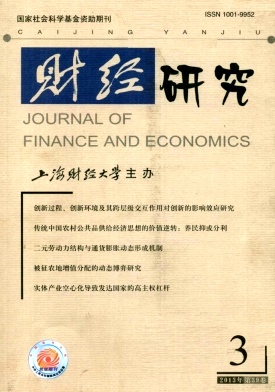开放经济中的财政政策规则——基于中国宏观经济数据的DSGE模型
财经研究 2013 年 第 39 卷第 03 期, 页码:136 - 145
摘要
参考文献
摘要
目前,鲜有文献讨论开放经济中的中国财政政策及其规则。文章通过构建开放经济的宏观财政DSGE模型,基于我国的宏观经济数据,研究了开放经济中的财政政策规则及其经济效应,比较了不同规则的结果。文章采取贝叶斯估计方法进行数值模拟后发现:在开放经济中,财政政策的即期"乘数效应"相对较小;"连续支出规则"与"盯住产出规则"具有相似的产出效应,在开放经济中可利用"盯住产出规则"发挥政府的主导性;"严格"债务约束的政策效应类似"宽松"债务约束的政策效应,为充分利用资源可采取后一政策规则。
[1]胡永刚,郭长林.财政政策规则、预期与居民消费——基于经济波动的视角[R].经济研究,工作论文WP330,2012.
[2]贾俊雪,郭庆旺.市场权力、财政支出结构与最优财政货币政策[J].经济研究,2010,(4):67-80.
[3]简志宏,李霜,鲁娟.货币供应机制与财政支出的乘数效应——基于DSGE的分析[J].中国管理科学,2011,(2):30-39.
[4]李生祥,丛树海.中国财政政策理论乘数和实际乘数效应研究[J].财经研究,2004,(1):5-20.
[5]刘斌.动态随机一般均衡模型及其应用[M].北京:中国金融出版社,2010.
[6]王文甫.价格粘性、流动性约束与中国财政政策的宏观效应——动态新凯恩斯主义视角[J].管理世界,2010,(9):11-27.
[7]张卫平.货币政策理论:基于动态一般均衡方法[M].北京:北京大学出版社,2012.
[8]Adolfson M,Laseen S,Linde J,et al.Bayesian estimation of an open economy DSGEmodel with incomplete pass-through[R].Sveriges Riksbank Working Paper Series No.179,2005.
[9]Almeida V,Castro G L,Félix R M,et al.Fiscal stimulus in a small Euro Area economy[R].Bank of Portugal Working Paper No.16/2010,2010.
[10]Andres J,Domenech R.Automatic stabilizers,fiscal rules and macroeconomic stability[J].European Economic Review,2006,50(6):1487-1506.
[11]Batini N,Levine P,Pearlman J.Monetary and fiscal rules in an emerging small openeconomy[R].IMF Working Papers No.09/22,2009.
[12]Christiano L,Eichenbaum M,Rebelo S.When is the government spending multiplierlarge?[J].Journal of Political Economy,2011,119(1):78-121.
[13]Gali J.Monetary policy,inflation,and the business cycle:An introduction to the newkeynesian framework[M].New Jersey:Princeton University Press,2008.
[14]Guo J,Janko Z.Reexamination of real business cycles in a small open economy[J].Southern Economic Journal,2009,76(1):165-182.
[15]Kumhof M,Laxton D.Simple,implementable fiscal policy rules[R].IMF Working Pa-per No.09/76,2009.
[16]Stahler N,Thomas C.FiMod-a DSGE model for fiscal policy simulations[R].DeutscheBundesbank Economic Studies No.06/2011,2011.
[2]贾俊雪,郭庆旺.市场权力、财政支出结构与最优财政货币政策[J].经济研究,2010,(4):67-80.
[3]简志宏,李霜,鲁娟.货币供应机制与财政支出的乘数效应——基于DSGE的分析[J].中国管理科学,2011,(2):30-39.
[4]李生祥,丛树海.中国财政政策理论乘数和实际乘数效应研究[J].财经研究,2004,(1):5-20.
[5]刘斌.动态随机一般均衡模型及其应用[M].北京:中国金融出版社,2010.
[6]王文甫.价格粘性、流动性约束与中国财政政策的宏观效应——动态新凯恩斯主义视角[J].管理世界,2010,(9):11-27.
[7]张卫平.货币政策理论:基于动态一般均衡方法[M].北京:北京大学出版社,2012.
[8]Adolfson M,Laseen S,Linde J,et al.Bayesian estimation of an open economy DSGEmodel with incomplete pass-through[R].Sveriges Riksbank Working Paper Series No.179,2005.
[9]Almeida V,Castro G L,Félix R M,et al.Fiscal stimulus in a small Euro Area economy[R].Bank of Portugal Working Paper No.16/2010,2010.
[10]Andres J,Domenech R.Automatic stabilizers,fiscal rules and macroeconomic stability[J].European Economic Review,2006,50(6):1487-1506.
[11]Batini N,Levine P,Pearlman J.Monetary and fiscal rules in an emerging small openeconomy[R].IMF Working Papers No.09/22,2009.
[12]Christiano L,Eichenbaum M,Rebelo S.When is the government spending multiplierlarge?[J].Journal of Political Economy,2011,119(1):78-121.
[13]Gali J.Monetary policy,inflation,and the business cycle:An introduction to the newkeynesian framework[M].New Jersey:Princeton University Press,2008.
[14]Guo J,Janko Z.Reexamination of real business cycles in a small open economy[J].Southern Economic Journal,2009,76(1):165-182.
[15]Kumhof M,Laxton D.Simple,implementable fiscal policy rules[R].IMF Working Pa-per No.09/76,2009.
[16]Stahler N,Thomas C.FiMod-a DSGE model for fiscal policy simulations[R].DeutscheBundesbank Economic Studies No.06/2011,2011.
引用本文
朱军. 开放经济中的财政政策规则——基于中国宏观经济数据的DSGE模型[J]. 财经研究, 2013, 39(3): 136–145.
导出参考文献,格式为:





 6325
6325  3279
3279

